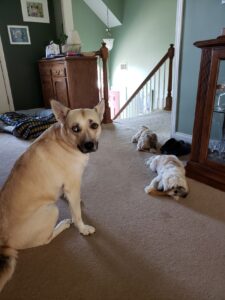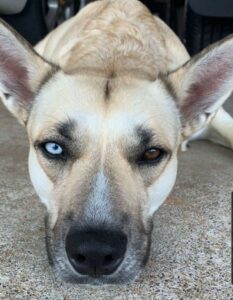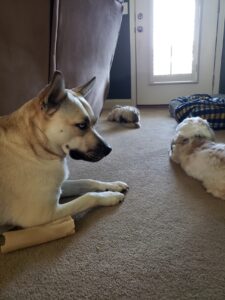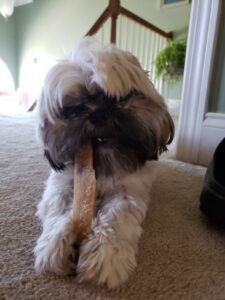When Robert and I took a trip to the beautiful mountainous area near Asheville, North Carolina to visit some good friends several weeks ago, we weren’t sure how well our dog, a Husky/Shepherd mix named Neko, would get along with the Parrish’s little Shih Tzu dogs. Neko is not always the most social butterfly when it comes to being around other dogs, especially those bigger than she is, so we weren’t sure what to expect. To our pleasant surprise, the pups played really well together! They chased each other, ‘play growled’, stole each other’s toys, and wore themselves out each day with all the fun they had! This was wonderful because Neko, having the high energy breeds mixed in her, needs daily stimulation and regular exercise; our kitties at home can attest to that!
Speaking of play growling, did you know dogs have several types of growls, with some indicating more aggression than others? People that regularly interact with dogs can tell the difference in the types of growls, especially when those growls are combined with the dog’s body language and stance. When excited and having fun, as our three pups were doing, their growling indicates excitement and happiness and a genuine desire to play. This growling was also matched with wagging tails and a few downward doggy bows that would make even the most experienced yoga professional jealous. 🙂
The fun picked up right where it left off when Mike and Caroline came to visit us recently, bringing their furbabies, Ruthie and Bilbeau, with them! Since Shih Tzu’s are well-known for their lively personality and active nature, they were excellent playmates for Neko, and once again the chasing and toy stealing games were on. Neko was quite the hostess, allowing the little pups to chew on her bones and toys and ta
Shih Tzu’s typically reach only up to eleven inches in height and up to sixteen pounds in weight; the perfect lap dogs. Neko did not feel threatened or uncomfortable at all and, in fact, had a healthy respect for the little ones. This is interesting, because it is not uncommon for bigger dogs to attack smaller ones (known as Big Dog Little Dog or BDLD) and, unfortunately, can sometimes lead to aggression and fighting.
Did you know dogs can measure each other up, size-wise, simply by listening to each other growl? This is quite a complex cognitive talent and only recently discovered by researchers.
Some other types of growling include:
-
-
-
-
- Pleasure growling – meant as a request for attention, for example, when being petted.
- Frustration growling – this usually occurs when a dog would like to meet or investigate another dog or person, for example, but is restrained or for whatever reason cannot. The growling is an indication of frustration at being restrained and is typically not meant as aggression.
- Threat growling – this is more difficult for the untrained eye to detect but is a way for the dog to try and maximize the distance between him/her and the perceived threat, whether another dog, person, or an object, like a bone. The mouth is usually closed, the body usually stiff, and the growl is usually a low sound. The situation can quickly escalate to an aggressive state if not managed.
-
-
-
We look forward to our next chance to get together with our good friends and their precious babies!
A special Thank You to Mike and Caroline Parrish, for their support in getting this blog written. Mike and Caroline own Treehouses of Serenity in Asheville, North Carolina (https://www.treehousesofserenity.com/). If you’re looking for rest and relaxation in a custom built treehouse, enjoying the stunning views of the North Carolina mountains, you must check this place out!




